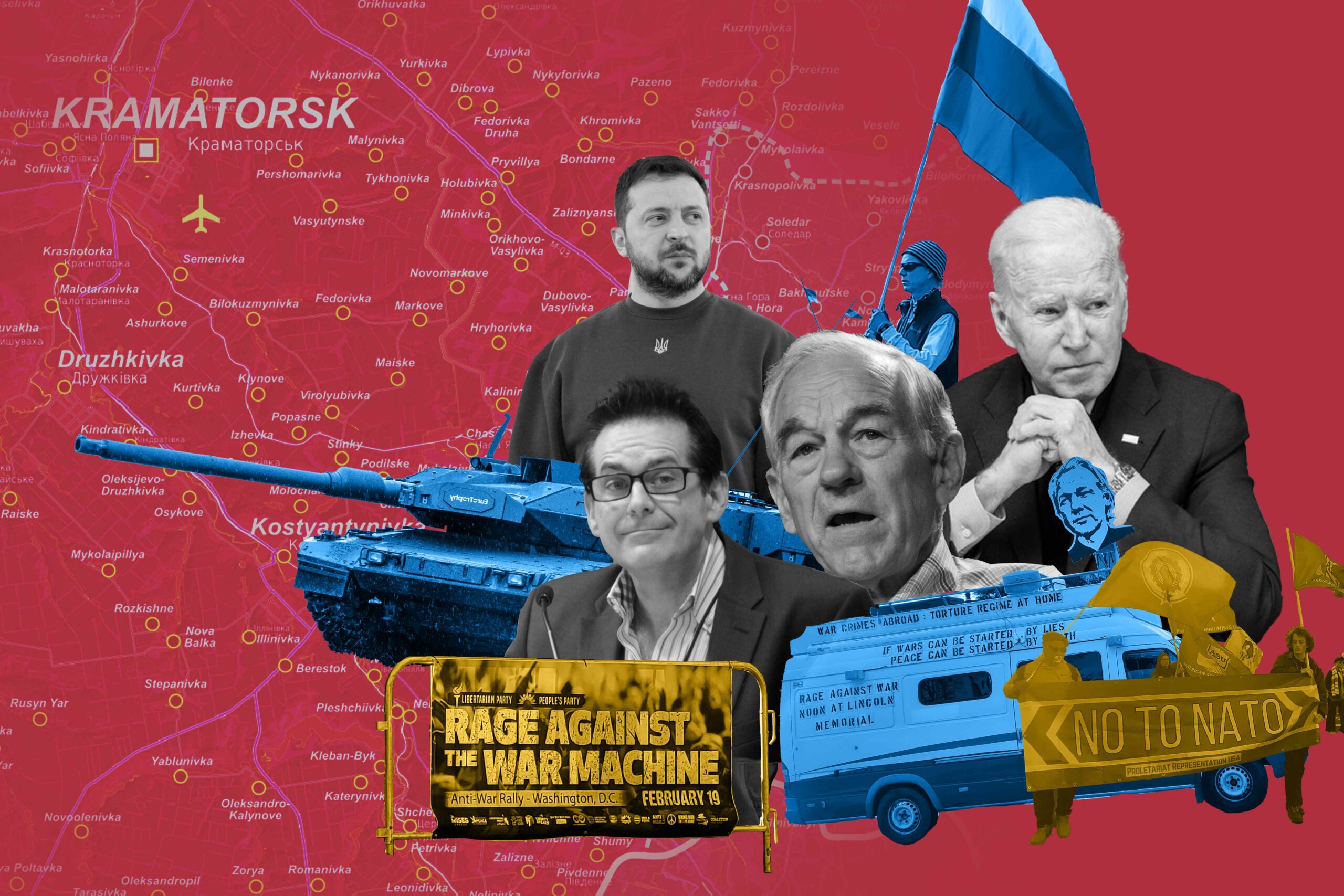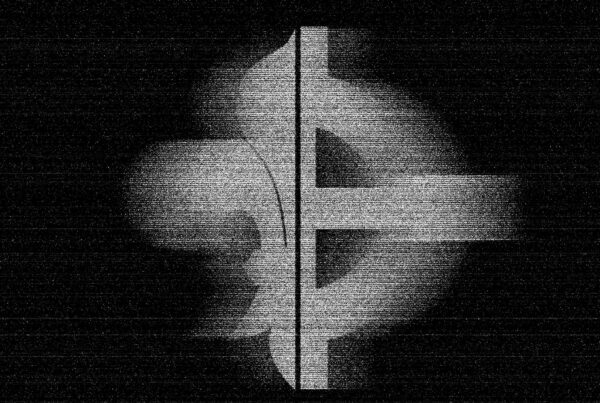
The Anti-War Coalition Visits Washington
John Chrobak
Illiberalism Studies Program Working Papers no. 15 March 2023
Photo by John Chrobak made using “Situation in the Donbas Region,” by Rr016 licensed under CC BY-SA 4.0; “Tank Leopard 2A7 NATO Days 2022,” by Fric.matej, licensed under CC BY-SA 4.0; “Ron Paul (6065152302)” by Gage Skidmore licensed under CC BY-SA 2.0; “Jimmy Dore (27945466546)” by Gage Skidmore licensed under CC BY-SA 2.0.
The contents of articles published are the sole responsibility of the author(s). The Institute for European, Russian, and Eurasian Studies, including its staff and faculty, is not responsible for any inaccurate or incorrect statement expressed in the published papers. Articles do not necessarily represent the views of the Institute for European, Russia, and Eurasian Studies or any members of its projects.
©IERES 2023
One year after Russia’s launch of its full-scale military invasion of Ukraine, Western allies are increasingly willing to provide the economic and military aid that Ukraine needs in its fight against Russia. The United States recently announced a $2.2 billion aid package that would include longer-range ground-based missile systems (Ground Launch Small Diameter Bombs), a weapon that would add new range to current Ukrainian capabilities.[1] Germany recently agreed to send Leopard 1 and Leopard 2 tanks to Ukraine.[2] The new Czech President, Petr Pavel, installed on January 28 after the country’s second round of presidential elections, also recently said that he saw “no reason for any limits” on the kinds of conventional weapons sent to Ukraine.[3]
As a whole (when including this latest aid package), the United States has provided Ukraine with $32 billion dollars in security assistance since 2014, with the vast majority of this sum ($29.3 billion) delivered after February 24, 2022.[4] This security assistance accounts for roughly 50% of the support that the United States has sent to Ukraine. Additional funds in financial and humanitarian assistance have been sent to Ukraine as well, though as a share of GDP, US assistance to Ukraine is dwarfed by the contributions of some European countries (notably Latvia and Estonia).[5] Individual members of the European Union have provided Ukraine with security assistance, while two-thirds of the EU’s assistance to Ukraine comes in the form of financial assistance.[6]
The provision of this support has not been without drama. In the United States, opposition to sending support to Ukraine has been quite pronounced from some of the more radical members of the Republican and Democratic parties alike.[7] Indeed, in March 2022, 69 members of the House of Representatives (54 Republicans and 15 Democrats) voted against sending aid. Congresswoman Marjorie Taylor Greene (R-GA) in particular has recently called for an audit into the aid that has already been sent to Ukraine.[8] After the Republicans’ taking back the House in the 2022 midterm elections, Speaker Kevin McCarthy’s statements that there would be no “blank check”[9] for Ukraine raised concerns that support for Ukraine from a Republican-controlled House may be harder to find.[10] Indeed, Republican representatives tend to be more cautious about providing aid than Democrats.[11] This split is also seen along partisan lines among voters. While in March 2022, 49% of Republicans believed that the United States was not providing enough aid to Ukraine, that number has now shrunk to 17% of as of January 2023; furthermore, 40% of them now believe too much aid is being given, compared to 9% in March 2022.[12] Among Democrats, in March 2022, 38% believed that not enough aid was being provided to Ukraine; now, that number stands at 23% (with 15% now believing too much aid is being, given compared to 5% in March 2022).[13] Nevertheless, support for Ukraine remains generally bipartisan between Republicans and Democrats and, among elected representatives, those calling for an end to aid are, for the moment, a minority.
Where fierce opposition to continued support for Ukraine does exist, it tends to appear in the more radical segments of the American political spectrum; particularly among libertarians and the far left.
Noninterventionism
“No entangling alliances”
The libertarian tradition in US foreign policy is quite markedly noninterventionist. The platform of the Libertarian Party emphasizes the need for a military budget sufficient “to defend the United States against aggression” while ending policies of “military and economic aid; tariffs; economic sanctions; and regime change.”[14] Indeed, often observed in the platform of the Libertarian Party are frequent referrals to avoiding “entangling alliances”—a reference to a quote from President Thomas Jefferson’s first inaugural address: “peace, commerce, and honest friendship with all nations, entangling alliances with none.”[15] The principle guiding this approach is the belief that the only legitimate role of government is “the protection of individual rights” and that the principle of non-initiation in the use of force “should guide relationships between governments.” This stance does not preclude the possibility of making preparations for defense against transgressions. Indeed, the use of force in defense of individual rights to life, liberty of speech and action, or property is held as the only legitimate use of force.
The foreign policy legacy built on this perspective is quite restrictive. Though legitimate use of force against a transgressor is allowed, responses to violations at a state level are not as clear-cut. Founder of the American libertarian movement and leading libertarian thinker Murray Rothbard outlined how, though there absolutely is a right for a violated party to respond to an aggressor that has wronged them, and that this extends beyond individuals to the state level, the indiscriminate nature of modern-day weapons and the reality of modern warfare facilitates the application of force against innocent individuals. According to Rothbard, the same bombs that target governments responsible for wrongs are bombs that bring injury to innocent lives. “War, then, is only proper when the exercise of violence is rigorously limited to the individual criminals.”[16]
However, this seemingly absolutist position on foreign policy against interventionism is not as hard and fast as one may initially be led to believe. Indeed, there are plenty of proposals for a moderated libertarian approach to foreign policy attuned to the realities of the world. Some, like Christopher Preble, who has suggested that peace be emphasized and war reserved as a last option, ought to be more seriously considered.[17] Others have suggested that “pro-war” libertarians may find themselves willing to accept limited-aim wars depending on how they interpret a state’s transgressions against individual rights.[18] Even the Cato Institute, a leading libertarian think tank, at one point advocated for the United States to “vigorously protect its vital national security interests using many means, including force,” though it did concede that absent a challenge to its hegemonic presence, the Untied States should be able to “rise above most day-to-day turmoil around the globe.”[19] Similarly, as part of its policy recommendations for the 108th Congress, the Cato Institute encouraged the United States to focus its efforts in the war on terror in targeting and combating al-Qaeda, specifically encouraging the government to “expand military operations into the Peshawar border region in Pakistan to root out al-Qaeda and Taliban forces” in neighboring Afghanistan.[20]
Still, it is this general adherence to noninterventionism that remains the fulcrum of libertarian perspectives on foreign policy. And it is precisely this opposition that has driven libertarian stances on Russia’s aggression against Ukraine. At the time of Russia’s annexation of Crimea in 2014, former Congressman Ron Paul (R-TX) expressed his support for the problematic referendum on Crimea’s status.[21] The sentiments of those like him produced a split among libertarians,[22] with some cautioning that libertarians should not be quick to excuse Russia’s “interventionist power grab.”[23] Nevertheless, the consistent message was that American imperialism was fundamentally to blame for Russia’s invasion of Ukraine and that the United States ought to work to remove itself from the equation. On January 25, 2022, nearly one month to the day before Russia’s launch of its full-scale invasion of Ukraine, the Libertarian Party published a statement criticizing continued US membership in NATO and broadly attributing Russia’s aggression to NATO’s expansion.[24] This position has remained consistent to this day and the Libertarian Party’s official stance on Ukraine is that the United States should “withdraw all financial and military support.”[25]
The Far Left
The narrative that the United States is to blame for Russia’s aggression against Ukraine has also found salience in parts of the far left both in the United States and internationally. The logic stems from a harsh critical perspective on US foreign policy as the embodiment of imperialism, though the logic of this argument varies. Noam Chomsky, linguist, philosopher, long-standing critic of US foreign policy and a particularly prominent figure on the left, has expressed a very similar take on the Euromaidan demonstrations and Russia’s full-scale invasion of Ukraine. While maintaining that Russia’s actions are a “criminal act of aggression” and that they are a “horrific [violation] of international law,” he has repeated the argument that US support for Ukraine to become a member of NATO, and historical expansion of NATO eastward, are to blame for provoking Russia’s aggression.[26]
Philosopher and political activist Cornel West is another prominent intellectual on the left who has been critical of US involvement in the war. In an interview with the New Yorker shortly after Russia’s full-scale invasion, he called for solidarity with Ukrainians and with Russians who protest against the war, but added that “the American empire has little or no moral authority when it comes to violation of international law and the overthrow of national sovereignty, as in Latin America, the Middle East, and Asia.”[27] Generally, West has been less overt about pinning the blame on NATO and the United States, preferring instead to criticize US foreign policy for its previous transgressions.[28]
At an institutional level, the Democratic Socialists of America (DSA), a growing democratic socialist political organization in the United States, has historically voiced its opposition to NATO and has adopted language condemning American foreign policy in its political platform.[29] On February 26, 2022, the DSA reaffirmed its objections to NATO and US foreign policy and maintained that no solution to the conflict could be found through war or further intervention.[30] The Party for Socialism and Liberation (PSL), the largest socialist political party in the United States (however marginal), released a statement on the day of Russia’s full-scale invasion of Ukraine that described Russia’s invasion as “the consequence of decades of U.S.-NATO bullying and humiliating Russia.”[31] The statement demands that the United States immediately cease its “provocative behavior” and provide security guarantees to Russia to restore peace. A number of articles have been published on the party website generally accuse the United States and Western allies of backing Russia into a corner and repeating “classic” narratives about how the United States put neo-Nazis into power in 2014.[32]
At face value, this rhetoric seems similar to that of the libertarian perspective; however, small differences stemming from the differences in ideology can be found. Among the libertarian objectives can be found opposition to the idea of taxes being used for the purposes of war. On the left (specifically the socialist side), claims tend to focus on the direct harm that war brings to the working class, and in some cases links are made between capitalism as a driving force of the military industrial complex and American imperialism.[33] Still, there is commonality in the opposition to US global leadership, the particular understanding of why Russia decided to invade Ukraine, and the nature of war in general that provides an opportunity for unity.
Indeed, this point of convergence has not been lost on the likes of Stephen Walt, who in 2018 called for libertarians and socialists to unite in order to disrupt the trajectory of contemporary US foreign policy and usher in a space for building a “restrained foreign policy.”[34] As it turns out, Walt’s wishes would, in some sense, shortly find their manifestation. The founding of the Quincy Institute for Responsible Statecraft in 2019 through funding from the Koch Foundation and the Open Society Foundations[35] produced this voice for a reserved and decidedly more noninterventionist foreign policy.[36]
The Quincy Institute’s official position on Russia’s full-scale invasion is less hands-off than those of some of the aforementioned individuals and organizations. It does, for instance, insist that the United States ought to “play an active role in seeking a negotiated peace” though its position of military strength.[37] And while it cautions against “advancing maximalist war aims such as regime change in Russia,” the general stance of the think tank is that negotiated peace through promises of concessions, such as the easing of sanctions and adjusted security arrangements, ought to be the priority rather than resolute military force. While this particular apparent meeting of the minds between left and right (at least through funding sources) remains relatively moderate in its reconceptualization of US foreign policy, there are more radical grassroots unions forming across the American political spectrum that are much more vocal in their opposition to war.
Rage against the War Machine
Both the progressive left and libertarians came together nearly one year after February 24 for a national rally in Washington DC. The goal was to gather in person and demand policy changes from President Biden and the US government. High on their list of demands were that the United States end funding for Ukraine, the United States work to pursue an immediate ceasefire and diplomatic end to the war, and that the United States disband NATO.[38] The list goes on, and includes calls for cutting defense spending by 50%, that the United States abolish the CIA and “deep state,” and for the liberation of Wikileaks founder Julian Assange. While the primary organizers of this rally were the Libertarian Party and the Movement for a People’s Party (a left-wing populist party founded by campaign staffers of Bernie Sanders)[39] the event had dozens of organizations, podcasts, and groups sponsoring the event.[40]
The event itself was attended by a few hundred people from a wide array of backgrounds. This point was emphasized by the speakers themselves, who proudly commented on how wonderful it was to see people from the left, the right, and all political ideologies coming together to demonstrate their anti-war commitments. Walking among the crowd, however, it became quite clear just how stark the ideological differences were between people as some quite proudly and publicly dressed for the occasion to showcase their political leanings. A number of attendees wore Ron Paul shirts, Libertarian Party pins, waved the Gadsden flag,[41] and held banners with the stylized porcupine representing the Libertarian Party, but there were some individuals with Make America Great Again (MAGA) style clothing, including one waving a large Trump 2024 flag.

Some attendees and speakers also had ties to extremist organizations such as the Proud Boys and Oath Keepers. Randy Ireland was identified[42] at the rally wearing a “Justice 4J6” (Justice for those arrested in connection with the January 6 assault on the Capitol) tee shirt, and Jordan Page, a singer and honorary member of the Oath Keepers, sang at the rally.[43] One-time white nationalists Matthew Heimbach[44] and Shandon Simpson[45] (both now claim to no longer adhere to that ideology) were also in attendance[46] waving flags of the Russian Empire, the Soviet Union, and the Russian presidential flag.
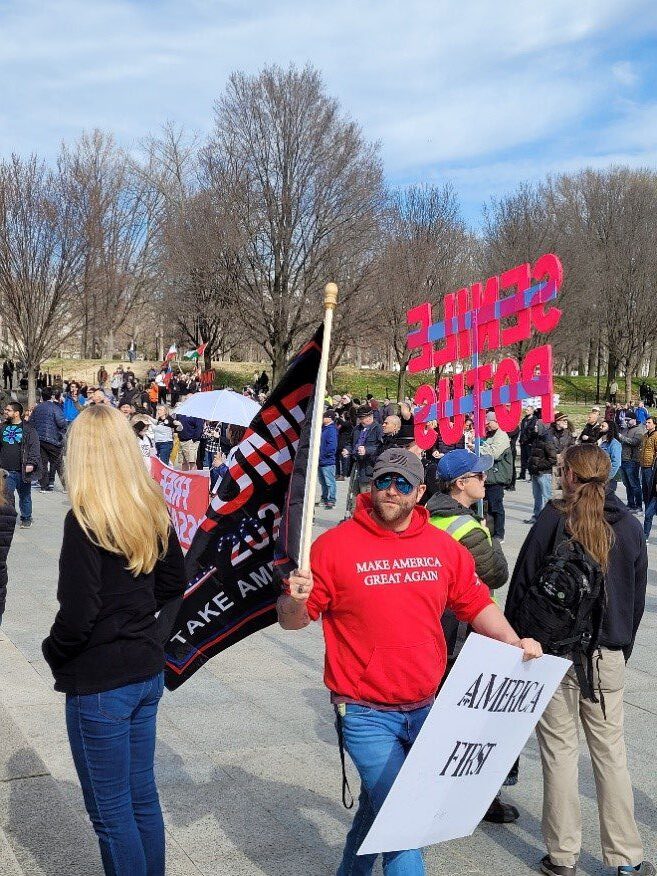
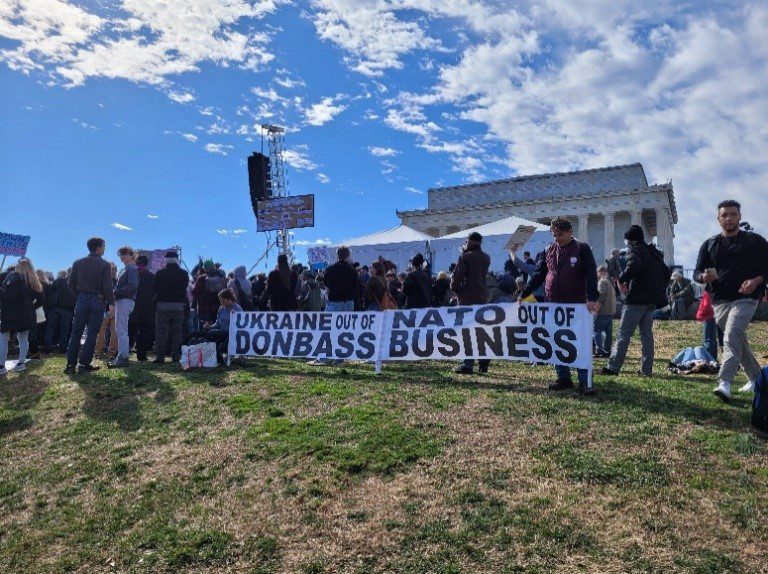
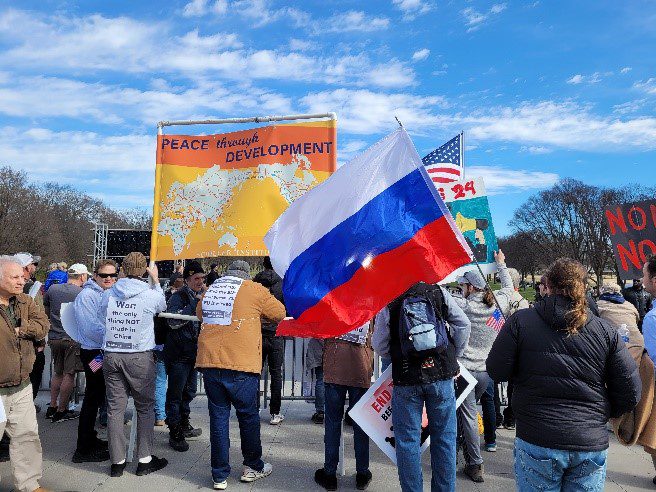
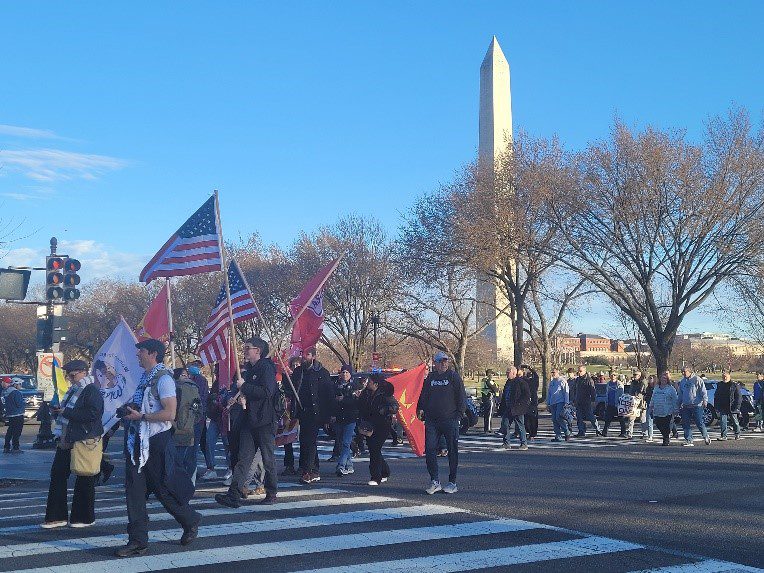
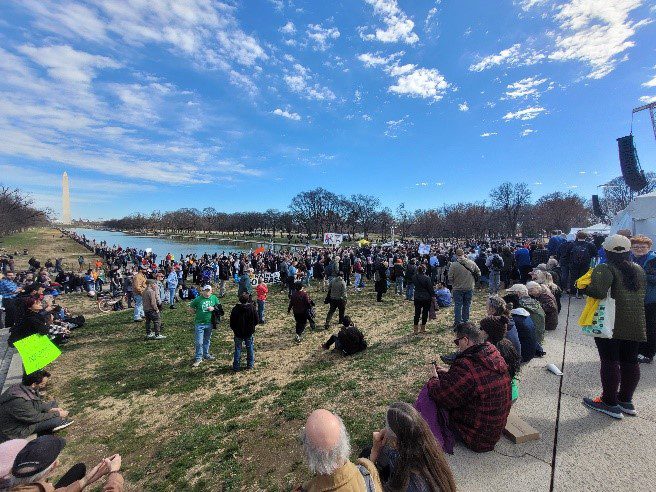
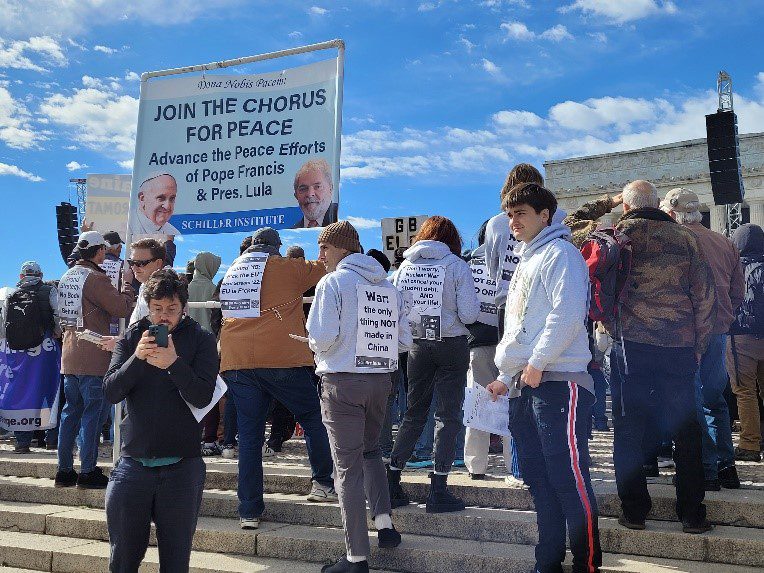
There were some members of the Russian diaspora in attendance as well. One individual wore a jacket and hat, matching the colors of his large Russian flag, with the word РОССИЯ (Russia) written on them. When asked why they were at the rally, one responded that he did not want his tax dollars paying for this “grazhdanskaia voina”(civil war). When asked whether they supported Putin, one individual enthusiastically responded, “Yes, I support Putin!” These individuals admitted that they had come to the United States many years ago and one lamented that there was not much of a Russian community near where he lived.
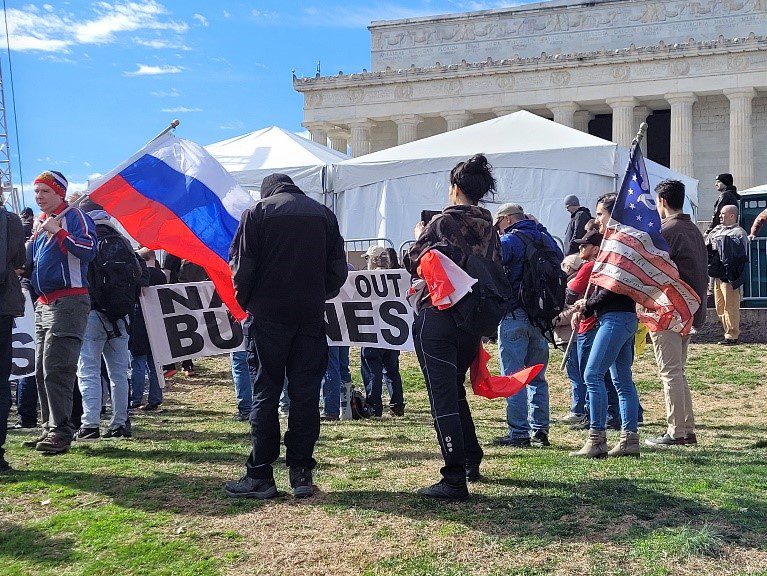
On the other end of the spectrum, one man from Texas who, when asked what he thought of the rally and the messages being conveyed, said that his main concern was with the lack of respect for the Bill of Rights, in particular the Ninth Amendment (that is: “The enumeration in the Constitution, of certain rights, shall not be construed to deny or disparage others retained by the people.”). Still others made their stances public via the signs they held. Some targeted NATO, calling the alliance a terrorist organization, while others called for Ukraine to get “out of Donbass” (using the Russian spelling), and still others focused their messaging on warning of the dangers of nuclear war, or calling for immediate ceasefires and peace deals.
The wide variety of the positions put forward by those in attendance mirrored the broad divergence of positions pronounced by the invited speakers. Many criticized US imperialism for its prior sins and drew analogies between Afghanistan, Iraq, and the Vietnam War with Ukraine. Many similarly highlighted the high cost of aid and suggested that those funds could be better spent ameliorating the lives of “ordinary Americans” (housing the homeless, feeding the hungry, etc.). Both of these criticisms were often uttered in the same breath with populist accusations that the US government and those who work for it are corrupt and no longer serve the interests of Americans. There were, however, some common themes that were repeatedly brought up:
1. The United States is responsible for blowing up the Nord Stream pipeline
This particular claim stems from a report published by Seymour Hersh on his Substack claiming that the United States executed a covert operation to blow up the Nord Stream pipeline.[47] Hersh’s story relies on a single anonymous source and suggests that the United States had planted explosives under the cover of the BALTOPS 22 maritime exercise in the Baltic Sea in June 2022,[48] and that on September 26, a Norwegian Navy P8 plane dropped a sonar buoy that served as the trigger for detonating the explosives. The report has been called false by the White House,[49] National Security Council Spokesperson John Kirby,[50] and the Norwegian Ministry of Foreign Affairs.[51] Additionally, journalists Oliver Alexander and Joe Galvin have provided their analysis of Hersh’s claims using open-source intelligence to poke holes in his analysis.[52] At the rally, assertions that the United States was responsible for the pipeline sabotages played into narratives of a covert “deep state” government provoking Russia and artificially creating a precursor for more military action.
2. NATO and US allies provoked Russia into invading Ukraine
This particular claim was emphasized by a number of speakers. In nearly all instances, the claim was immediately preceded by acknowledgement that Russia’s invasion of Ukraine was illegal and wrong. In the words of 2016 Green Party US presidential nominee Jill Stein:
The US empire has been provoking war with Russia for decades. However murderous and illegal the Russian invasion is, and all wars are murderous and almost all wars are illegal, that Russian invasion was a provoked response to an even bigger, more murderous, illegal game plan of the US empire in which defeating Russia is just one small part. So yes, Russia illegally invaded Ukraine but did so with a gun to its head. Or in this case, nuclear-compatible missiles to its head.[53]
Many of the speakers repeatedly emphasized that the United States had made promises to Russia about NATO expansion and that progressive inclusion of Central and Eastern European states were not only a violation of those promises, but were deliberately ignorant of and flippant towards Russia’s legitimate security concerns about its periphery. The reality is that discussions on the post-Cold War order among American and European leaders were far more ambiguous than otherwise suggested by speakers at the rally and, arguably, played a minor role in the security crisis.[54]
3. Funds spent on Ukraine could be better spent domestically
This particular claim was repeated multiple times by many speakers. Some, like Chris Hedges, did so seriously, highlighting “joblessness and food insecurity,” “financial speculation,” “constant surveillance,” and “militarized police,” as “the only real concerns of the state.”[55] Stand-up comedian, political commentator, podcaster, and YouTube personality Jimmy Dore in particular spent a large portion of his time making jokes about things that the United States could buy in lieu of sending funds and arms to Ukraine, including: a dog that knows where to lead President Biden when a press conference is over, a tank of gas for every American, eggs, a home for every American, 7,000 Ukraine-flag fleece blankets for every homeless American, and a blue Twitter checkmark for every person on Earth.[56] One particularly odd inclusion illustrative of the blend between serious points and comedy in Dore’s speech was: “Why are we sending that money to Nazis in Ukraine when we could be funding Nazis here in America struggling to buy eggs?” This last passing comment about Nazis in Ukraine was repeated by others including Jackson Hinkle, who asked attendees to “demand not one more bullet, not one more tank, not one more gun, not one more piece of artillery, not one more dollar, not one more penny be sent to the Nazis in Ukraine! Demand peace!”[57]
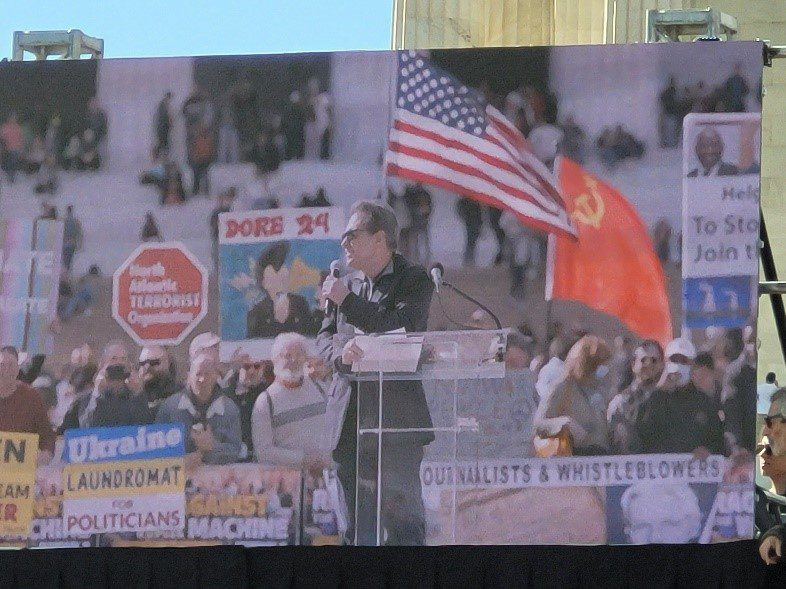
A Cacophony of Messages
If reading the overview of the messaging and the personalities present at the rally seems chaotic and scattered, it is largely because the actual experience was itself scattered. Between the anti-government messages calling for the dismantling of the CIA and NATO, the populist rhetoric denouncing elected officials as corrupt and self-serving, and the warnings of the dangers of nuclear war, there was little to be had in terms way of consistent messaging. Much of what was said at the rally was a reformulation of some of the major talking points advanced by Russia in its effort to justify its presence in Ukraine and discredit efforts to support Ukraine. Others focused on the negative legacy of American foreign policy, while still others included a sprinkling of anti-vaccine and conspiratorial messengers.[58] That war was bad was the one clear message, but proposed solutions were diffuse. To be sure, speakers spoke of a need for an immediate ceasefire and a negotiated resolution to the conflict, but many seemed content to levy criticisms at America and its allies.
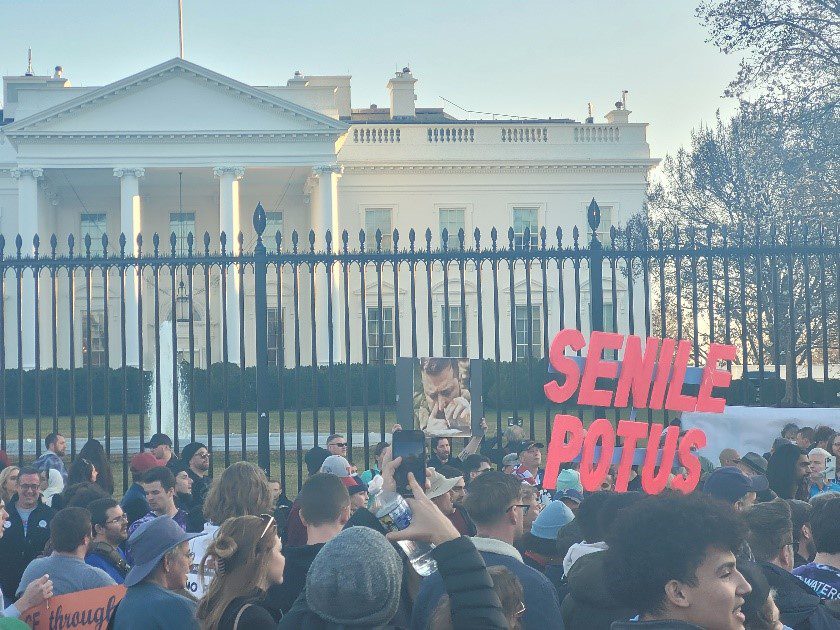
Being against war writ large is a good thing. No one, least of all Ukrainians, welcomes this war, and even the most ardent supporters of Ukraine would welcome a reality in which Russia was not violating Ukraine’s territorial sovereignty and bombing civilian populations. But however good as a principled stance in opposition to war may be, it must contend with the reality of the conflict. Putin’s record regarding his perspective on Ukraine has been made quite clear in his declarations on the lack of legitimacy of an independent Ukraine.[59] Moreover, in the lead-up to February 24, 2022, Western efforts to engage with the Russians in an attempt to address security concerns proved fruitless, and all indications pointed to the notion that Russia was dead set on launching a full-scale invasion.[60] As long as Russia continues to deny the legitimacy of Ukraine’s right to exist as an independent sovereign state, it is impossible to see an avenue whereby both Ukraine and Russia can come to the negotiating table of their own volition and begin talks. Thus far, Russia’s position has been that Ukraine must first recognize (that is, concede) the Ukrainian oblasts of Donetsk, Kherson, Luhansk, and Zaporizhzhia as Russian territory pursuant to Russia’s announced annexation of those territories in September 2022.[61] For Ukraine to come to the negotiating table now would be to compromise its own territorial integrity and legitimize Russia’s illegal enlargement of its borders. A cessation of aid to enable Ukraine to resist Russia’s continued aggression would not be a neutral act. It would be a free pass to legitimize aggressive land grabs.
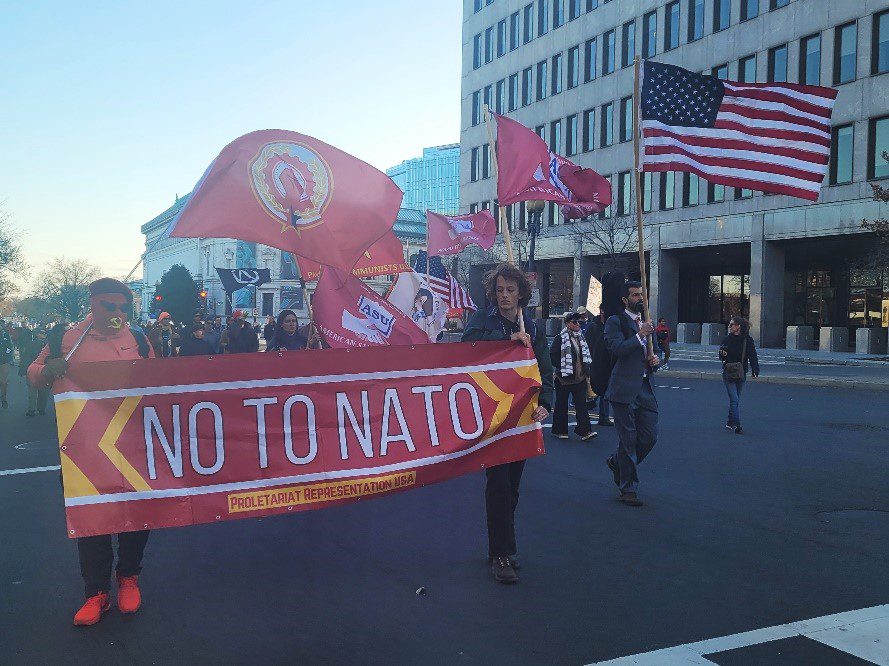
Conclusion
It would be easy to dismiss the rally as nothing more than a hodgepodge collection of Putin’s “useful idiots”[62] and pro-Russian vatniks (a pejorative term used to describe someone who is a blind supporter of Russian government narratives). But this would be a mistake. Firstly, however qualified their stances may be, they do claim that, at least officially, they oppose Russia’s invasion.[63] While this is the bare minimum that one ought to expect from an anti-war stance, labeling them all as pro-Russian is a mischaracterization of their position that misses the arguments for that stance.
Secondly: dismissing the demonstration would miss a key point about the future potential that such anti-war stances may have. While the crowd gathered in front of the Lincoln Memorial was not as large as the one that gathered at the same location just one week later in support of Ukraine (despite much colder and snowier weather), and while Western public opinion and leadership remains committed to supporting Ukraine, it is important to remember that this could change. The Rage Against the War Machine rally was not the only anti-war demonstration that day. Indeed, there were a host of sister rallies organized in multiple locations across the United States.[64] In addition, an anti-war rally[65] took place in Munich in connection with the Munich Security Summit and many others are planned in a dozen other countries over the coming months.
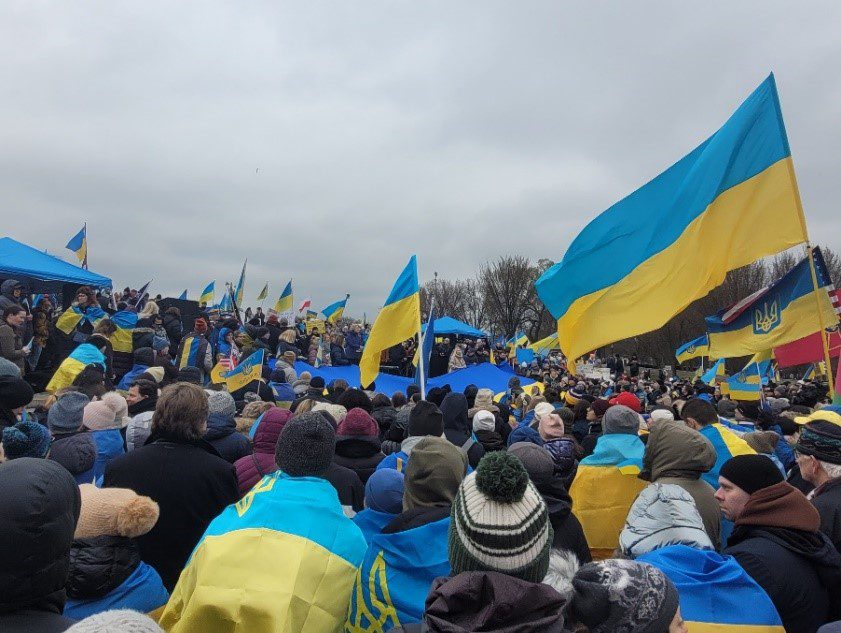
That being said, we should be cautious not to grant too much importance to such demonstrations. While they should not be ignored and dismissed as the clamoring of the irrelevant political fringes, neither should they be given more serious attention than warranted. With radical demands such as slashing the military budget by 50% and dismantling the CIA, the movement is unlikely to garner serious support from a wider audience, but with high-profile events such as the protest on February 19 and a more sober policy proposal, such efforts may find success in persuading an audience that is increasingly critical of the level of support the United States is offering to Ukraine. This is exactly the lesson that should be drawn here. The gathering of socialists and libertarians with a sprinkling of the far right is unlikely to become a political juggernaut and sway public opinion to reject support for Ukraine. If public opinion on aid to Ukraine changes, it will be for other reasons. But the messages heard on February 19, especially those about the high cost of aid, may be a taste of what broader publics in Western countries start repeating.
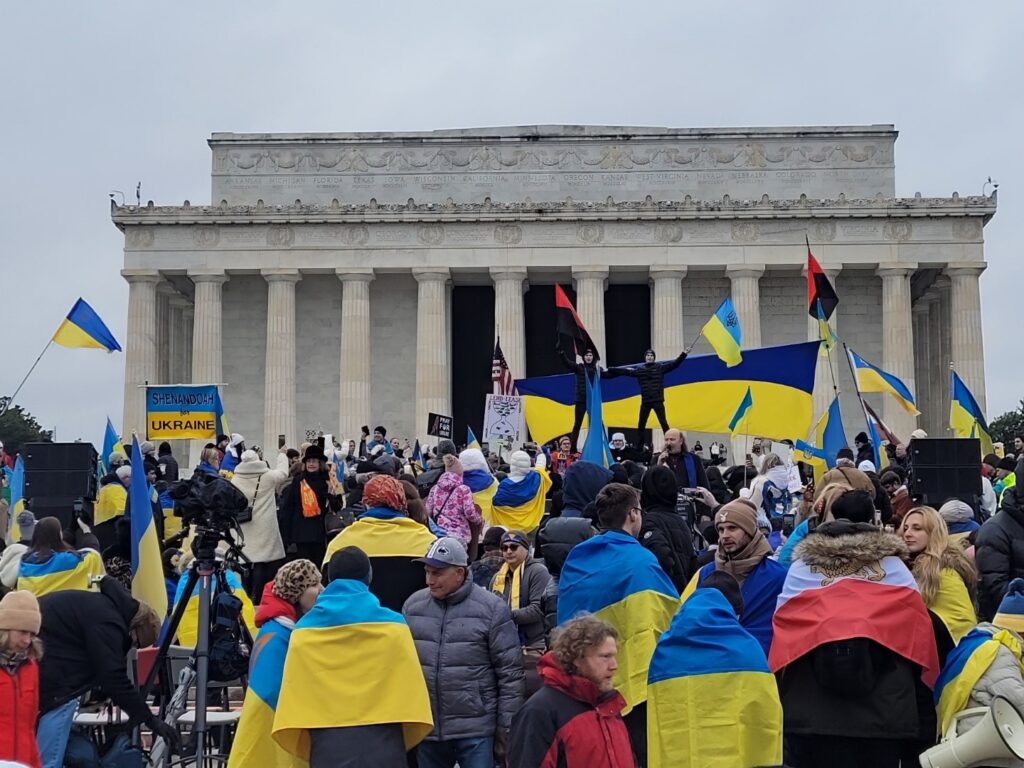
© Photo—John Chrobak.
[1] US Department of Defense, “Biden Administration Announces Additional Security Assistance for Ukraine,” February 3, 2023, https://www.defense.gov/News/Releases/Release/Article/3287992/biden-administration-announces-additional-security-assistance-for-ukraine/.
[2] Erika Solomon, “Germany adds older Leopard 1s to the list of tank for Ukraine,” The New York Times, February 3, 2023, https://www.nytimes.com/2023/02/03/world/europe/germany-ukraine-leopard-1-tanks.html.
[3] “New Czech leader urges ‘no limits’ on aid to Ukraine,” France 24, February 2, 2023, https://www.france24.com/en/live-news/20230202-new-czech-leader-urges-no-limits-on-aid-to-ukraine.
[4] Christina L. Arabia, Andrew S. Bowen, and Cory Welt, “U.S. Security Assistance to Ukraine,” Congressional Research Service IF12040 VERSION 23, Accessed February 27, 2023, https://crsreports.congress.gov/product/pdf/IF/IF12040.
[5] Jonathan Masters and Will Merrow, “How Much Aid Has the U.S. Sent Ukraine? Here Are Six Charts,” Council on Foreign Relations, February 22, 2023, https://www.cfr.org/article/how-much-aid-has-us-sent-ukraine-here-are-six-charts.
[6] “EU assistance to Ukraine,” European Commission, Accessed February 27, 2023, https://eu-solidarity-ukraine.ec.europa.eu/eu-assistance-ukraine_en.
[7] Elana Schor, “How Ukraine split the GOP,” Politico, February 28, 2023, https://www.politico.com/newsletters/politico-nightly/2022/02/28/how-ukraine-split-the-gop-00012394; House Congressional Progressive Congress, “CPC Letter for Diplomacy on Russia Ukraine Conflict,” https://progressives.house.gov/_cache/files/5/5/5523c5cc-4028-4c46-8ee1-b56c7101c764/B7B3674EFB12D933EA4A2B97C7405DD4.10-24-22-cpc-letter-for-diplomacy-on-russia-ukraine-conflict.pdf.
[8] Julia Shapero, “Marjorie Taylor Greene to introduce bill to audit US aid to Ukraine,” The Hill, February 24, 2023, https://thehill.com/homenews/house/3872365-marjorie-taylor-greene-to-introduce-bill-to-audit-us-aid-to-ukraine/.
[9] Emily Brooks, “McCarthy defends ‘blank check’ remark on Ukraine,” The Hill, October 19, 2022, https://thehill.com/homenews/house/3695482-mccarthy-defends-blank-check-remark-on-ukraine/.
[10] Sasha Stone, James Lamond, Mackenzie Eaglen and Chris Miller, “Will a Split Congress Threaten US Aid to Ukraine?,” Center for European Policy Analysis, January 6, 2023, https://cepa.org/article/will-a-split-congress-threaten-us-aid-to-ukraine/.
[11] Aris Folley and Laura Kelly, “Divided GOP tiptoes on Biden request for more Ukraine aid,” The Hill, November 20, 2022, https://thehill.com/policy/finance/3742226-divided-gop-tiptoes-on-biden-request-for-more-ukraine-aid/.
[12] Amina Dunn, “As Russian invasion nears one-year mark, partisans grow further apart on U.S. support for Ukraine,” Pew Research, January 31, 2023, https://www.pewresearch.org/fact-tank/2023/01/31/as-russian-invasion-nears-one-year-mark-partisans-grow-further-apart-on-u-s-support-for-ukraine/.
[13] Ibid.
[14] Libertarian Party, “Platform,” May 2022, https://www.lp.org/platform/.
[15] Thomas Jefferson, “First Inaugural Address,” March 4, 1801, The Avalon Project at Yale Law School, https://avalon.law.yale.edu/19th_century/jefinau1.asp.
[16] Murray N. Rothbard, “War, Peace, and the State,” Mises Institute, November 29, 2017, https://mises.org/library/war-peace-and-state.
[17] Christopher Preble, “Libertarians and Foreign Policy: The Individual, the State, and War,” The Independent Review 21 no. 2 (Fall 2016) 167-179.
[18] Randy E. Barnett, “Libertarians and the War,” The Wall Street Journal, July 17, 2007, https://www.wsj.com/articles/SB118463507387568429.
[19] “General Strategy and U.S. Foreign Policy,” CATO Institute, https:/www.cato.org/research/general-strategy-us-foreign-policy, Archived at: http://web.archive.org/web/20181030004028/https:/www.cato.org/research/general-strategy-us-foreign-policy.
[20] CATO Institute “Policy Recommendations for the 108 Congress,” CATO Handbook for Congress, https://www.cato.org/sites/cato.org/files/serials/files/cato-handbook-policymakers/2003/9/hb108-5.pdf
[21] Paul Lewis, “Ron Paul slams US on Crimea crisis and says Russia sanctions are ‘an act of war’,” The Guardian, March 15, 2014, https://www.theguardian.com/world/2014/mar/15/ron-paul-crimea-russia-sanctions-act-of-war.
[22] Dalibor Rohac, “Time For A Rethink?: Libertarians and Foreign Policy,” World Affairs 178 no. 2 (Summer 2015), 91-96.
[23] John Glaser, “Where a Libertarian Should Stand on Crimea,” Anti War Blog, March 26, 2014, https://www.antiwar.com/blog/2014/03/26/where-a-libertarian-should-stand-on-crimea/.
[24] Libertarian Party, “No War With Russia,” January 26, 2022, https://www.lp.org/no-war-with-russia/.
[25] @LPNational, “Ukraine is not a state, territory, or enclave of the US. The American regime should stop treating it like one, and withdraw all financial and military support. Sending $100 billion to Ukraine while Americans suffer through inflation is criminal,” February 26, 2023, https://twitter.com/LPNational/status/1629873422879604740.
[26] Bill Fletcher Jr., “Noam Chomsky: A Left Response to the Russian Invasion of Ukraine,” The Real News, April 8, 2022, https://therealnews.com/noam-chomsky-a-left-response-to-the-russian-invasion-of-ukraine.
[27] Vinson Cunningham, “Cornel West Sees a Spiritual Decay in the Culture,” The New Yorker, March 9, 2022, https://www.newyorker.com/culture/the-new-yorker-interview/cornel-west-sees-a-spiritual-decay-in-the-culture.
[28] Chris Hedges, “The Chris Hedges Report with Dr. Cornel West,” The Real News, April 15, 2022, https://therealnews.com/the-chris-hedges-report-with-dr-cornel-west.
[29] “DSA IC says “No to NATO”,” DSA International Committee, June 11, 2021, https://international.dsausa.org/statements/dsa-says-no-to-nato/.
[30] “On Russia’s Invasion of Ukraine,” Democratic Socialists of America, February 26, 2022, https://www.dsausa.org/statements/on-russias-invasion-of-ukraine/.
[31] Party for Socialism and Liberation, “PSL Statement on Russia’s military intervention in Ukraine,” Liberation News, February 24, 2022, https://www.liberationnews.org/psl-statement-on-russias-military-intervention-in-ukraine/.
[32] “Tag: Ukraine” Liberation News, https://www.liberationnews.org/tag/ukraine/; Liberation Staff, “How and why the U.S. government aided a coup led by neo-Nazis in Ukraine ,” Liberation News, March 4, 2014, https://www.liberationnews.org/why-us-aided-ukraine-coup-russia-html/.
[33] George Martin Fell Brown, “Socialists and the War in Ukraine: A Response to the Party for Socialism and Liberation,” Socialist Alternative, April 4, 2022, https://www.socialistalternative.org/2022/04/04/socialists-and-the-war-in-ukraine-a-response-to-the-party-for-socialism-and-liberation/.
[34] Stephen M. Walt, “Socialists and Libertarians Need an Alliance Against the Establishment,” Foreign Policy, September 24, 2018, https://foreignpolicy.com/2018/09/24/socialists-and-libertarians-need-an-alliance-against-the-establishment/.
[35] Joshua Keating, “Why It Makes Sense That Soros and Koch Are Uniting to Fund a New Anti-War Think Tank,” Slate, July 3, 2019, https://slate.com/news-and-politics/2019/07/soros-koch-anti-war-quincy-institute.html.
[36] “About QI,” Quincy Institute for Responsible Statecraft, https://quincyinst.org/about/.
[37] Quincy Institute, “Quincy Institute’s Position on Russia-Ukraine,” Quincy Institute for Responsible Statecraft, July 12, 2022, https://quincyinst.org/2022/07/12/quincy-institutes-position-on-russia-ukraine/.
[38] “Demands,” Rage Against the War Machine, https://rageagainstwar.com/#Demands.
[39] Draft Bernie, “Press Release: Draft Bernie Launches ‘Movement for a People’s Party’ Amid Explosive DNC Rigging Revelations and Record Support for a Major New Party,” Draft Bernie, November 9, 2017, https:/draftbernie.org/2017/11/09/press-release-draft-bernie-launches-movement-peoples-party-amid-explosive-dnc-rigging-revelations-record-support-major-new-party/, Archived at: https://web.archive.org/web/20201109035714/https:/draftbernie.org/2017/11/09/press-release-draft-bernie-launches-movement-peoples-party-amid-explosive-dnc-rigging-revelations-record-support-major-new-party/.
[40] “Coalition,” Rage Against the War Machine, https://rageagainstwar.com/#Coalition.
[41] Rob Walker, “The Shifting Symbolism of the Gadsden Flag,” The New Yorker, October 2, 2016, https://www.newyorker.com/news/news-desk/the-shifting-symbolism-of-the-gadsden-flag.
[42] @socialistdogmom, “proud boy randy ireland is packing up his livestreaming rig & heading home,” February 19, 2023, https://twitter.com/socialistdogmom/status/1627392553405276160.
[43] Elias Alias, “Jordan Page: Arm Yourselves!,” Oath Keepers, August 21, 2015, http:/oathkeepers.org/oktester/jordan-page-arm-yourself/, Archived at: http://web.archive.org/web/20150823040105/http:/oathkeepers.org/oktester/jordan-page-arm-yourself/.
[44] Elle Reeve, “How White ‘replacement theory’ evolved from elderly racists to teens online to the alleged inspiration for another racist mass homicide,” CNN, May 21, 2022, https://www.cnn.com/2022/05/20/us/replacement-theory-white-supremacist-buffalo-shooter/index.html.
[45] Dan Lamothe and Souad Mekhennet, “Soldiers Cases Highlight Reach of White Extremism Into US Military,” The Washington Post, June 25, 2020, https://www.washingtonpost.com/national-security/soldiers-cases-highlight-reach-of-white-extremism-into-us-military/2020/06/25/0203532e-b582-11ea-9b0f-c797548c1154_story.html
[46] @socialistdogmom, “here at the “rage against the war machine” rally in dc, matthew heimbach & shandon simpson tell me they aren’t white nationalists “anymore,” and simpson denies ever being a member of atomwaffen. color me unconvinced!,” https://twitter.com/socialistdogmom/status/1627369481071742979.
[47] Seymour Hersh, “How America Took Out The Nord Stream Pipeline,” Seymour Hersh Substack, February 8, 2023, https://seymourhersh.substack.com/p/how-america-took-out-the-nord-stream.
[48] Press Office of the US Navy “BALTOPS 22, the premier Baltic Sea maritime exercise, concludes in Kiel,” Official Website of the US Navy, June 17, 2022, https://www.navy.mil/Press-Office/News-Stories/Article/3066830/baltops-22-the-premier-baltic-sea-maritime-exercise-concludes-in-kiel/.
[49] “White House says blog post on Nord Stream explosion ‘utterly false’,” Reuters, February 8, 2023, https://www.reuters.com/world/us/white-house-says-blog-post-nord-stream-explosion-is-utterly-false-2023-02-08/.
[50] Olivia Olander, “John Kirby denies U.S. sabotaged Nord Stream pipelines,” Politico, February 19, 2023, https://www.politico.com/news/2023/02/19/john-kirby-nord-stream-seymour-hersh-00083589.
[51] Guy Faulconbridge and Vladimir Soldatkin, “Kremlin says those behind Nord Stream blasts must be punished,” Reuters, February 9, 2023, https://www.reuters.com/world/europe/russia-calls-international-probe-into-nord-stream-blasts-after-blogger-report-2023-02-09/.
[52] Oliver Alexander, “Blowing Holes in Seymour Hersh’s Pipe Dream,” Oliver Alexander Substack, February 10, 2023, https://oalexanderdk.substack.com/p/blowing-holes-in-seymour-hershs-pipe; @Joey_Galvin, “Wanted to check what I was capable of checking regarding the Hersh piece. There are facts presented that do allow for some open-source work, namely the setting of the explosives via a Norwegian Alta-class minesweeper, and the dropping of a sonar buoy by a Norwegian P8…,” February 8, 2023, https://twitter.com/joey_galvin/status/1623459664334659585?s=48&t=bNJXYXZ_OHbUpZ8tg-ayGA.
[53] Jill Stein, “Rage Against the War Machine Rally,” People’s Podcast, February 19, 2023, video of speech, 30:16, https://www.youtube.com/watch?v=duKeWROIp_Y&t=1816s.
[54] Svetlana Savranskaya and Tom Blanton, “NATO Expansion: What Gorbachev Heard,” National Security Archive Briefing Book #613, December 12, 2017, https://nsarchive.gwu.edu/briefing-book/russia-programs/2017-12-12/nato-expansion-what-gorbachev-heard-western-leaders-early; Svetlana Savranskaya and Tom Blanton, “NATO Expansion: What Yeltsin Heard,” National Security Archive Briefing Book #621, March 16, 2018, https://nsarchive.gwu.edu/briefing-book/russia-programs/2018-03-16/nato-expansion-what-yeltsin-heard; Kirk Bennet, “What Gorbachev Did Not Hear,” The American Interest, March 12, 2018, https://www.the-american-interest.com/2018/03/12/gorbachev-not-hear/.
[55] Chris Hedges, “Chris Hedges speaks at Rage Against the War Machine,” People’s Podcast, February 20, 2023, video of speech, 7:21, https://www.youtube.com/watch?v=lZOLtFjfFv4&t=441s
[56] Jimmy Dore, “Rage Against the War Machine Rally,” People’s Podcast, February 19, 2023, video of speech, 58:30, https://www.youtube.com/watch?v=duKeWROIp_Y&t=3510s.
[57] Jackson Hinkle, “Rage Against the War Machine Rally,” People’s Podcast, February 19, 2023, video of speech, 22:30, https://www.youtube.com/watch?v=duKeWROIp_Y&t=1350s.
[58] Diane Sare, “Rage Against the War Machine Rally,” People’s Podcast, February 19, 2023, video of speech, 10:42, https://www.youtube.com/watch?v=duKeWROIp_Y&t=642s.
[59] Vladimir Putin, “Article by Vladimir Putin ”On the Historical Unity of Russians and Ukrainians,” Official Website of the President of Russia, July 12, 2021, http://en.kremlin.ru/events/president/news/66181; Billy Perrigo, “How Putin’s Denial of Ukraine’s Statehood Rewrites History,” Time, February 22, 2022, https://time.com/6150046/ukraine-statehood-russia-history-putin/.
[60] Erin Banco, Garrett M. Graff, Lara Seligman, Nahal Toosi and Alexander Ward, “‘Something Was Badly Wrong’: When Washington Realized Russia Was Actually Invading Ukraine,” Politico, February 24, 2023, https://www.politico.com/news/magazine/2023/02/24/russia-ukraine-war-oral-history-00083757.
[61] Mark Trevelyan, “As he seizes Ukrainian lands, Putin is silent on war failings,” Reuters, September 30, 2022, https://www.reuters.com/world/putin-declare-annexation-ukrainian-lands-major-escalation-war-2022-09-29/.
[62] David A. Graham, “Putin’s Useful Idiots,” The Atlantic, February 24, 2022, https://www.theatlantic.com/ideas/archive/2022/02/russia-ukraine-war-republican-response/622919/.
[63] Libertarian Party, “Statement from The Libertarian Party,” February 7, 2023, Official Website of the Libertarian Party, https://www.lp.org/statement-from-the-libertarian-party-on-anti-war-rally/.
[64] “Sister Rallies,” Rage Against the War Machine, https://rageagainstwar.com/rallies/.
[65] “Münchner Mittwochsumzug,” Müenchen Steht Auf, Accessed on February 28, 2023, https://muenchen-steht-auf.de; “Munich Security Conference: Anti-war protests as world leaders discuss stepping up military aid,” Euronews, February 19, 2023, https://www.euronews.com/2023/02/19/munich-security-conference-anti-war-protests-as-world-leaders-discuss-stepping-up-military; Sweta Choudhury, Standing Against The Warmongering Tide – Protests For Peace Around The World This Weekend,” February 23, 2023, https://www.stopwar.org.uk/article/standing-against-the-warmongering-tide-protests-for-peace-around-the-world-this-weekend/.


